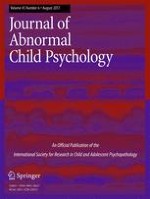08-11-2016
Parenting and Anxiety: Bi-directional Relations in Young Children
Gepubliceerd in: Research on Child and Adolescent Psychopathology | Uitgave 6/2017
Log in om toegang te krijgenAbstract
Developmental psychopathologists have long posited a reciprocal relation between parenting behaviors and the development of child anxiety symptoms. Yet, little empirical research has utilized a longitudinal design that would allow exploration of this bi-directional influence. The present study examined the reciprocal relations between parental respect for autonomy, parental hostility, and parental support, and the development of childhood anxiety during a critical developmental period-the transition from preschool to kindergarten and then first grade. Study participants included a community sample of 391 male and 405 female socioeconomically, racially and ethnically diverse 4 to 6–7 year olds. 54 % of the sample was White, non-Hispanic, 16.8 % was African American, 20.4 % was Hispanic, 2.4 % were Asian and 4.4 % self-identified as Other or mixed race. Parent report and observational methodology were used. Parenting and anxiety were found to interact reciprocally over time. Higher levels of age 4 anxiety led to reduced respect for child autonomy at age 5. At age 4 higher levels of parental hostility led to small increases in age 5 anxiety, and increased age 5 anxiety led to increased levels of age 6 parent hostility. Parental support at age 5 resulted in decreased anxiety symptoms at age 6–7 while higher age 5 anxiety levels were associated with reductions in age 6–7 parental support. No relations were found between these variables at the younger ages. Although the magnitude of these findings was small, they suggest that early treatment for childhood anxiety should include both parent intervention and direct treatment of the child’s anxiety symptoms.
